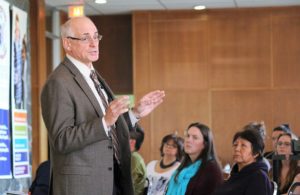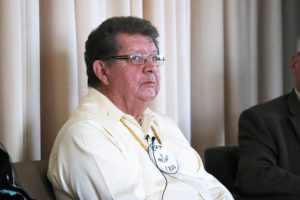Victory and loss in the Robinson Huron Treaty Trial

By Catherine Murton Stoehr
SUDBURY—The audience at a Robinson Huron Treaty trial panel was startled this week when, half-way into a measured, lawyerly PowerPoint presentation they saw the title:
“The Insidious Cancer of Excessive Delay in Resolving Indigenous Legal and Justice Issues.”
That unexpected emotional shock set the tone for an event where the human cost of treaty breaking across the centuries, and of pursuing treaty litigation, repeatedly broke out into the open.
Hosted by Sarah Rice, the University of Sudbury’s director of Indigenous Portfolio, the panel featured Robinson Huron history teaching by Atikameksheng Anishnawbek Elder Art Petahtegoose, Mike Restoule, chair of the Robinson Huron litigation trust, summarizing the process thus far, and the Honourable Stephen O’Neill who spoke to the broader context of Indigenous litigation in Canada.
O’Neill offered the case of the Wiikwemkoong Islands Land Claim to make the point that the Canadian courts’ delay in adjudicating Indigenous land and rights claims constitutes an “insidious cancer.” The people of Wiikwemkoong began fighting for justice in 1862, when their neighbours signed the Manitoulin Island Treaties. 156 years of petitions, protests, and submissions later, the people of Wiikwemkoong are still negotiating with the government.
“Wiikwemkoong people have lives, children and families, and they pass into the Spirit World without their claims resolved,” stated O’Neill.

O’Neill displayed the names of five such people then turned his head aside, quiet for a long moment.
“They’ve lost too much along the way.”
Two sitting Chiefs attended the event, Ogimaa Peltier from Wiikwemkoong Unceded Territory and Chief Scott McLeod of Nipissing First Nation.
Chief McLeod asked the audience to reconsider what true victory in the Robinson Huron case might mean. Likening any financial settlement that Canada and Ontario could possibly afford to returning a set of tires after stealing a car as recompense, he said, “Setting the record straight, and where we go from there—that’s the victory.”
Stephanie Pheasant, a first year Indigenous Studies major from Wiikwemkoong, said that she came to the panel “to show honour.” Noting that “it’s up to the younger generation to honour what was started in the past by the ancestors.”
Pheasant picked up the theme of the unrecoverable loss of justice delayed saying the presentations really opened her eyes.
Pheasant reflected that hearing about the treaty augmentation promise, so long unfulfilled, made her, “trace back generations of hurt. It really struck a chord in me and it hurts.” Adding later that “as much as it hurts, it motivates you, these people [the panelists] are fighting with us and for us.”
Asked what she had learned that Anishinabek News readers might like to know, Pheasant’s third year colleague, Sonnie Debassige of M’Chigeeng First Nation, laughed that after attending the event, she may possibly be able to keep up with her Grandmother and Auntie who are already very knowledgeable about the history of this struggle.
A few stories shared demonstrated that in, through, and alongside the trial process, some versions of “setting the record straight” are already happening.
Elder Petahtegoose talked about the experience of having the Wampum agreements present in the Robinson Huron Trial courtroom.
“It was beautiful to see when we went in there, to see those belts on the table…. We laid that one down.”

The Superior Court Justice Patricia Hennessy, the government and First Nation legal teams collaborated to build a protocol that would enable Indigenous Elders to testify in court. Restoule, who has himself worked for more than a quarter of a century to bring the Robinson Huron claim forward, reported that the courts’ efforts “turned out really well—Elders were treated very well in that court.”
Pheasant, who lives on Robinson Huron territory, said that it was hard for her to find a school for her four-year-old daughter. Of the four schools available, three did not offer Anishinaabe teachings. One did. When she walked into her first parent – teacher interview, a young, non-Indigenous teacher greeted her with an unprompted “Aanii.”
The climate in the room itself suggested that Chief McLeod’s hope for victory of going forward in a better way may be possible. Audience and speakers interacted gently, speakers concluding their remarks with Miigwetch, and listeners responding with murmurs of the same rather than applause.
The real importance of the financial settlement itself was never far from people’s minds.
During the question period, Laurentian business professor Ron Mulholland shared that the Sudbury mining camp alone had produced one trillion dollars in revenues. Robinson Huron communities, many of whom struggle financially, have sought their fair share of such profits since 1851.
“Today we’re talking about the financial side [of the treaty],” noted Elder Petahtegoose in his concluding remarks. “What kind of future are we going to find for our people today? My children have suffered enough.”


